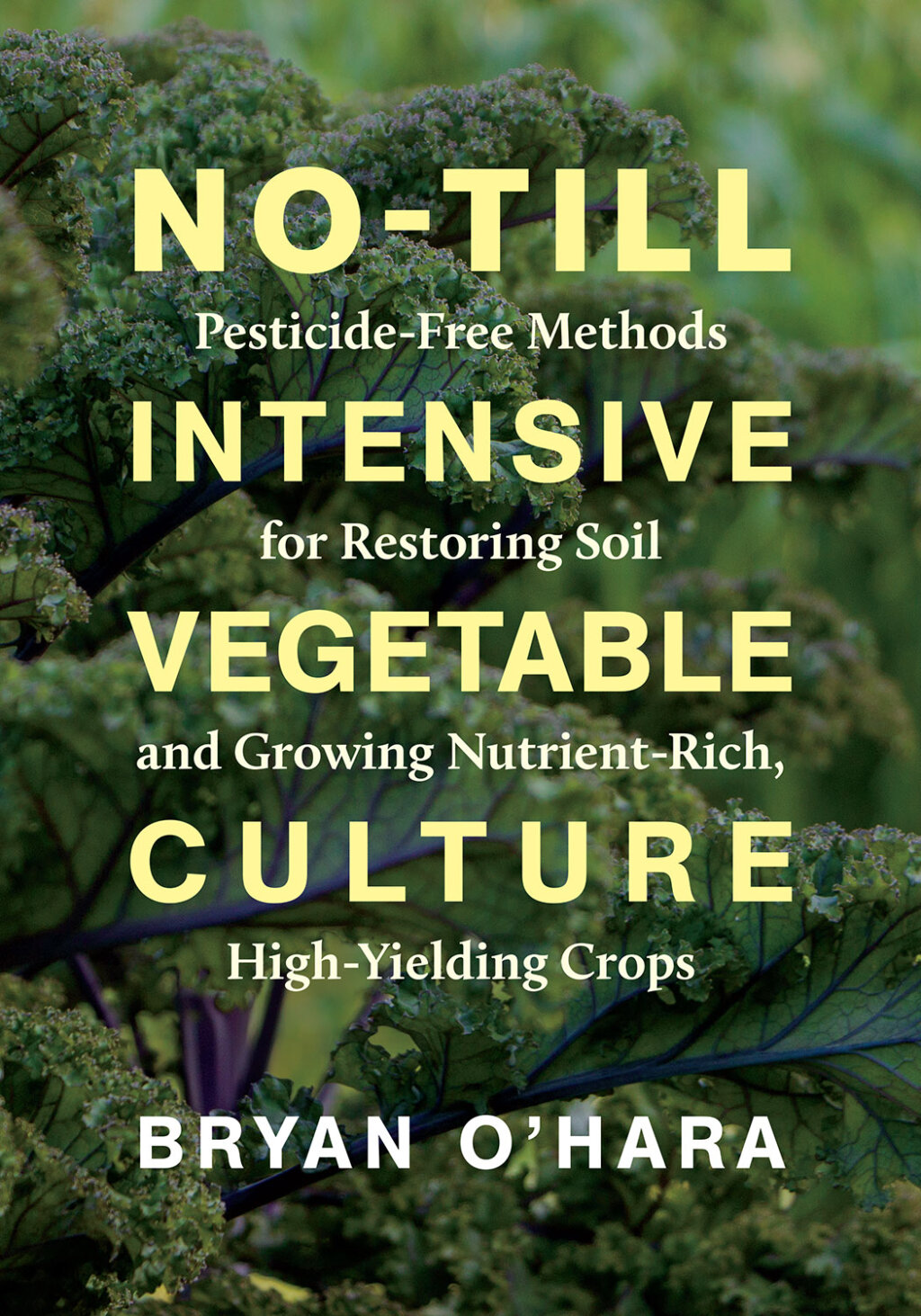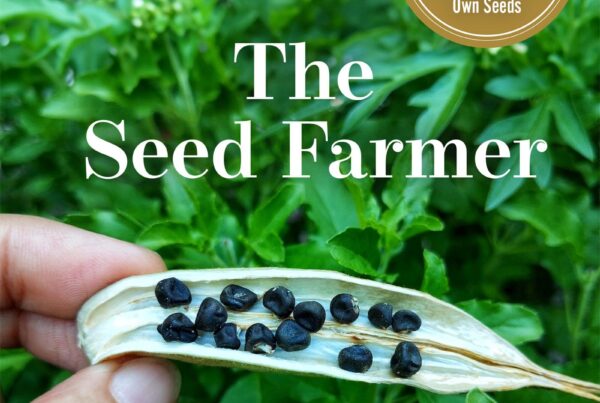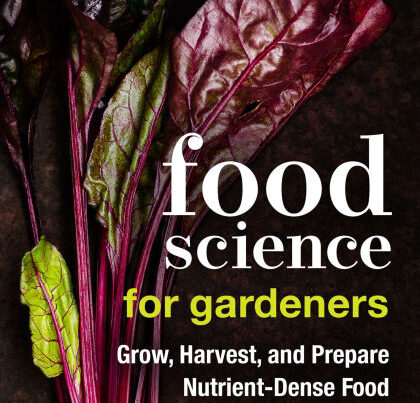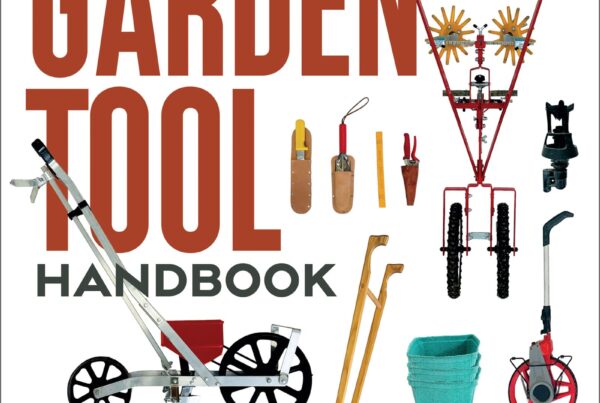Bryan O’Hara’s No-Till Intensive Vegetable Culture is the work of an expert. His bio says he is known for “providing mountains of details in a concise, practical and cohesive mannerâ€, which sounds like my kind of writer!
His book includes science, art, and philosophy. It is an example of something I realized a while ago: if a farmer pays good attention to what works well, and acts in accordance with their observations, it doesn’t seem to me to matter exactly why they think it works! Although I don’t share the author’s spiritual outlook, or practice of Biodynamics, I do highly value healthy soil, diverse ecosystems, crop rotations, nutritious food, good relations with our neighbors and peace in the world. And so I can use the pointers to achieve some of these goals. Bryan has been paying exquisite attention for decades!
This no-till book is very different from Andrew Mefferd’s Organic No-Till Farming Revolution: High-Production Methods for Small-Scale Farmers which I reviewed in May 2019. That book provides a menu of varied methods for those who want to increase the amount of no-till growing on their small-scale farm. Any reduction in tillage is a good step: you don’t have to commit to permanent no-till everywhere. Read Andrew’s book first and choose the reduced-tillage options that suit your farm. Then read Bryan’s book on one particular way of no-till vegetable production and see which parts will work for you.
Bryan and his partner Anita started farming in Connecticut in the early 1990s. Experienced, enthusiastic and energetic, they quickly succeeded, and prepared to expand Tobacco Road Farm. Fortunately, Anita realized the three acres of vegetables they already had was a better fit with their goals: providing for their family year-round, keeping them healthy and happy, providing a service to fellow humans, and freedom from economic subjugation. They embraced Biodynamics as a way to improve crop health, and then Korean Natural Farming. KNF (developed by a Korean, Cho Han Kyu) and making brews of microorganisms (IMOs).
After noticing that tillage was detrimental to their soils, they switched to no-till and were stunned at the differences. The vegetables taste wonderful!
Bryan writes an inspirational narrative, without any fluffy chat. It’s like being in conversation with him. Not everyone can make a discussion of soil quality so engaging! He has a suitable humility about stepping in and influencing the fine balance of the ecosystem. His advice: “be careful not to get in the way of delicate, naturally functioning systems.â€
I was surprised to find that Bryan believes that long-lasting condensation trails left by high-flying aircraft under certain conditions are actually “chemtrails” of chemical or biological agents secretly sprayed on us, rather than water-vapor. I do agree that airplane flights significantly add to climate chaos. We who sometimes fly have the responsibility for this, not secret government departments. Like Bryan, I lament the erratic weather, the decline in insect populations, and the struggle to provide water for our livestock and crops in appropriate quantities and rates of distribution.
Bryan describes increasing or decreasing the strength of both or just one side of the growth/reproduction polarity of plant development. Keep the balance of air and water in the soil. Steer things in the direction your crops need. Don’t let the soil dry out, as many life-forms will die, and recovery won’t be instant. But how do we get there from here? Bryan offers suggestions for what to look for when “reading†the appearance of crops in terms of balance. Rank growth? Stunted? Sparse? Obvious nutrient deficiencies? Good yield? Color?
Bryan suggests monitoring the conditions of the soil, air, sunlight and water. Whether you see this as a manifestation of Pagan Earth/Air/Fire/Water elements, or a simple description of aspects of farming doesn’t matter to me. As an example, if you want consistent supplies of an annual cool weather crop, sow several successions in spring (because they will quickly bolt) but fewer in late summer because they will not bolt. Once you understand this, you can follow the cycle of “plan/execute/observe/adjust plan†and get the best possible fit of crops with markets. Your approach may be mystical or pragmatic, but your attention to results will be detailed either way.
If you are drawn to Biodynamics, I think you’ll love this book. If you are drawn to very successful crops, I think you’ll also love this book. You just might skim some it.
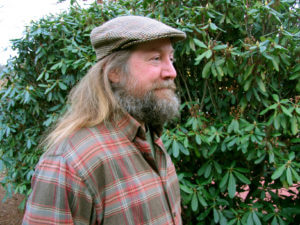 The next section of the book is about preparing land for a gradual transition to no-till. Don’t expect to make an overnight change! Try various approaches on small areas. Reduce your tillage until you no longer need any, or just need occasional tillage. Don’t worry that opening a furrow for big seeds, or digging up root vegetables, will get you expelled from the No-Till School! Try to avoid tilling simply to prepare seed beds.
The next section of the book is about preparing land for a gradual transition to no-till. Don’t expect to make an overnight change! Try various approaches on small areas. Reduce your tillage until you no longer need any, or just need occasional tillage. Don’t worry that opening a furrow for big seeds, or digging up root vegetables, will get you expelled from the No-Till School! Try to avoid tilling simply to prepare seed beds.
Various conversion methods are explained, even clearing woody growth. First set up a system that doesn’t need primary tillage (usually heavy tractor equipment), but uses secondary tillage tools (rototillers, disk harrows, field cultivators, walking tractors, hand rakes and hoes) for bed prep (and occasional subsoiling to deal with hardpan).
Bryan recommends a three step process for killing old crops or weeds. First is mowing: Bryan most often uses a flail mower on a 16 hp BCS 850. Second is preventing regrowth by solarizing using clear plastic sheeting to heat the soil surface to 125F or more, for a day. Unlike solarizing to kill pathogens deeper in the soil, killing annual crops or weeds is very quick, provided air temperatures are 75F or more. Perennial roots will not solarize quickly – it’s best to remove these before transitioning. Those that arrive later will need digging out, or longer term solarizing using black silage tarps over the winter. For anti-plastic growers, organic mulches of cardboard covered in 2 ft of fresh cut hay can substitute. There is a good review of various mulching materials, and the photos show his own trials. Oak leaves (and coffee grounds) seem to repel slugs!
Mowing or rolling and crimping is another method, given a thick cover crop and good timing. Flaming can work to kill emerging weeds if any mulch is well-watered first. Reading the book will save you trying all the cover-management methods that don’t work well. At Tobacco Road Farm, they now solarize as much as ¼ acre at a time, moving the covers from plot to plot.
The chapter on seeding and transplanting includes a chart of planting methods, seeding rates and spacing for about 65 crops (not just the top twenty!), instructions for hand broadcasting, sowing in rows by hand or by EarthWay. They have learned to get the most from their Earthway, customizing plates, leaning right while pushing, and only half-filling the hopper for round seeds (to avoid the “brassica grinder†effect).
The transplanting section describes clearly how to make use of outdoor nursery seedbeds for growing bare root transplants as we do. For more delicate seedlings February-June, Bryan likes soil blocks on benches under shadecloth or rowcover tunnels.
Watering by hand must be a joy once the farm gets to the point of only needing water for new seeds and new transplants. We’re not there yet, and so must continue dealing with drip “irritation†and sprinklers.
The crop rotation chapter includes a planning chart showing what goes in each plot when throughout the course of a year. The system includes flexibility: if a crop continues to grow well in a spot, it doesn’t get rotated. That challenges one of my cherished beliefs! My next challenge came with the information about the influence of the moon on crop growth. I have raised eyebrows myself, claiming that frosts are more likely with a full moon. It sounds so woo-woo, but it fits my observations. Perhaps Bryan is more observant of details, more woo-woo than me, or both. I’m happy he acknowledges that sometimes a crop needs to be planted regardless of lunar position.
Next is a valuable chapter on soil fertility and crop health assessment. This is an area I would like to practice in more. Not just testing pH and the main minerals, but also the Brix measurement of sugar in the crop sap, the electrical conductivity, and soil compaction. Bryan gives a good explanation of cation exchange capacity (the nutrient-holding capacity), and points out the challenges of achieving a good high CEC and then of adjusting the elemental nutrient balance: you need large amounts of material to bring the elements into balance, compared with a low CEC soil. And never forget: “the objective is not to balance a soil test but to get results in the field.†Strong biological activity can outweigh chemical element imbalances.
A slightly acid pH of 6.5 helps cations be more available to the plants: the acidity favors a higher level of fungal activity, which releases nutritional elements held in bonds that resist bacterial action.
Phosphorus buildup is an issue for us growers who use a lot of compost. It is hard for labs to assess phosphorus levels, because many factors influence its soil availability. Compost grows strong plants which in turn reduce water pollution, including phosphorus. Looking at the big picture leads to different solutions than focusing down on soil phosphorus content. Soils high in OM often test high in P because the test includes all the P-containing living fragments. Water-quality regulators are focused on phosphorus contamination of waterways above and beyond that of other pollutants like excess synthetic nitrogen fertilizers and industrial byproducts.
The information on composting is thorough, and Bryan recommends up to 100 tons per acre for a new vegetable patch. Thereafter, 30 tons or more per acre pre-plant. There is a good comparison of various organic fertilizers, and instructions on making bonemeal after cooking meat. There are fish fertilizer recipes which (to my surprise) call for “unprocessed brown sugar.†When I was a hippy grocer in the 70s, our sugar supplier told us there was really no such thing as unprocessed brown sugar – all brown sugars are white sugar with various proportions of molasses added back in. There’s no more nutritional value in brown sugar than in white sugar. Even “raw†sugar isn’t raw. I guess the only unprocessed sugar is a length of sugar cane or a chunk of sugar beet! Is sugar a big evil, like a synthetic fertilizer, that we don’t want to add to our gardens, or does it have a place?
Some growers apply raw manures, or uncomposted food byproducts directly to the soil, (“sheet composting†or “trench compostingâ€) in the fall for crops the following spring. It’s certainly less work than making a compost pile, but is the result as balanced as a composted mix? Everyone has to make their own decisions. Bryan takes a thoughtful look at these options, and milk, seaweed, charcoal, vinegar and more.
He gives us his precise recipes for liquid and solid feeds for seed-starting, for young plants, and for flowering plants; recipes to be modified by growers for their own conditions. He adds particular ingredients to the base recipe of 30% wood chips, 20% dead leaves or straw, 40% cattle manure and 10 % vegetable scraps.
After this we get into the production of Biodynamic preparations, which do seem to require faith. Working barefoot and stirring a bucket of potion to create a vortex is a step too far for me. But for the grower who wants to learn about these techniques from an expert farmer rather than another beginner, this is a good place. Here are recipes for Biodynamic horsetail tea and Preparations 501 (ground quartz) and 500 (horn manure) as well as Oriental Herbal Nutrient (OHN), a fermented herbal preparation, and Fermented Plant Juice (FPJ) from Korean Natural Farming. “With this stirring comes the opportunity to impart the forces of will or prayer into the material, so this is a time of concentration or maybe a song.â€
Next are the Indigenous Microorganisms (IMO). This is part of Korean Natural Farming, and involves “farming†captured forest microorganisms (most noticeably, fungi) with a bait of cooked grain. There are four stages. Making IMO #1 involves incubating cooked grain (mixed with sugar) perhaps with some duff from the forest floor. The lidded box is set in a forest, covered over with more duff, and left for a week. Once white fungal mycelia (and perhaps other colors of fungi) cover the surface of the grain, you have IMO #1. The box is brought back from the forest and further processed to produce a large pile of active life.
IMO #1 is mixed 1:1 by weight with sugar in a crock, which is covered with paper and kept at room temperature for a week. This is IMO #2. To make IMO #3, stir this material in water and mix with bran. Pile the damp material on the forest floor, cover with wet leaves, straw or cardboard and tarp if it’s rainy. The pile heats up and produces more white fungal growth. After about 5 days, make IMO #4. Add an equal volume of soil to the bran pile and mix in. After about a week the material is ready to use. IMO #4 can be spread directly on the beds at 5 gallons per 250 ft2, approximately every other year. Or it can be used as a foliar feed. It acts as a catalyst to grow stronger plants. Improvements to the soil can include better aggregate structure, and better release of nutrients.
Weed, insect and disease control come next in the book, necessary but not directly income-earning aspects of farming. Increasing crop health and vitality for the long term is of fundamental importance here. There is a sense in which pests can be useful: as indicators of an imbalance that the grower would do well to address.
Reducing the weed seed bank is a long-term improvement. Destroy weeds as they germinate, and do not bring up weed seed by tilling. Try not to import weed seed with brought-in materials. Since Bryan was able to stop tilling, galinsoga no longer pops up [envy!]. Crop rotation can help break weed cycles by altering the growing environment. Switch between cool weather and warm weather crops, soil-covering crops and vertical crops, and keep roots in the ground all the time.
Stale seed beds and shallow hoeing can kill weeds without tillage, and solarization can kill not only germinated seeds but ungerminated ones near the surface. Mulches can prevent weed seed germination. Good hoeing technique and tools can remove the weeds that still pop up.
Don’t over-react if problems arise. Monitor pests or diseased plants and count a sample. Determine if the pest numbers warrant your intervention. Also determine if it’s too late to save that crop. Learn if managing the crop differently next time might make it more resistant to pests or diseases. It might take a season or two for changes to pay off in terms of stronger crops. Carefully look for any improvement, as an indicator that your actions are steering things in the right direction.
Beneficial insects, rowcovers, insect netting, shadecloth, shelterbelts and other kinds of crop protection all help crops grow stronger. I learned that our friends, the Cotesia glomerata wasps that parasitize brassica caterpillars, and overwinter as pupal cocoons on the undersides of brassica leaves, will hatch out in spring on the very day the overwintered brassicas start to flower. The 20-50 day lifecycle needs brassica flowers, so don’t be in a hurry to cut down all your bolting greens! The flowers provide nectar for the adult wasps. The leaves, as we know, provide food for the caterpillars, which provide the host for the wasps to lay eggs in. The wasp larvae feed on the caterpillar until it dies, then pupate.
There’s an incredible National Geographic video of this cycle, showing parasitic wasp larvae swimming around inside a caterpillar, bursting out through its skin. The weirdest bit is that it is the dying caterpillar that spins the protective cocoons around the pupating larvae. And us who plant the brassicas that feed the caterpillars! Who is the farmer and who is farmed?
The next chapter is on organizing things to produce vegetables year round. Off-season growing takes more attention and understanding than growing the crops at the easiest time of year. And can bring higher prices and more appreciation. People do want to eat year-round! Protective structures can earn their keep. Tobacco Road Farm uses lots of low tunnels in their snowy winters. Snow cover is actually a benefit to low tunnels, holding the covers in place, and providing insulation. In our climate, I think hoophouses work better. Because our winter weather switches back and forth from cold and icy to warm and sunny, we would spend a lot of time ventilating low tunnels. Without snow cover, we suffer wind and radiation losses through the clear plastic on cold nights.
We need to harvest more frequently than growers in colder climates (not complaining!), and the stooping over, opening and closing of low tunnels gets tiresome. We appreciate walking around in our (no-till) hoophouse, where all the crops are visible at once. Different climates call for different solutions. If you are working with winter low tunnels, read this book and learn how to customize a snow shovel for clearing snow from the tunnels, by rounding and smoothing the corners of the blade. And here are tips for charring sawdust to melt thicker snow. They use a pump to blast a slurry of charred sawdust, salt and molasses over the tunnels. Sounds like a fun winter activity!
Bryan points out how healthy, sturdy crops will have a longer shelf life after harvest, paying back the year-round attention to soil and environmental health. Here are tips on ergonomic harvesting of small crops at ground level (rest one elbow on your knee) and efficient harvesting (while cutting, decide where to make the next cut). The speed of decision-making can be the bottleneck in harvesting, so practice to speed your decision-making.
Why do we grow vegetables? To meet basic human needs for health and happiness; to provide healthful foods, with the potential for job satisfaction and happiness. Sometimes slogging through and finishing a project is the most efficient. Sometimes switching to a different plan is more efficient (or at least, effective). Efficiency includes having a plan and having the flexibility to change plans.
The Further Reading includes a list of twenty books, and I am honored to be among those 26 authors. There is only one other woman among the authors. Bargyla Rateaver is from Madagascar, and with her son Gylver Rateaver, she wrote The Organic Method Primer in 1993. Some reviewers and obituary writers refer to Bargyla as “heâ€. Farmers are not all of one gender (or of one color). Thanks Bryan for including some of the diversity that exists.
At the beginning of this review I said it was not a “menu†book, but a “specific method†book. Then I found myself picking and choosing from the ideas Bryan presents. It really isn’t a fixed meal. There is something everyone will love in this accomplished work. You don’t have to add all the Special Sauces.
Book Review: No-Till Intensive Vegetable Culture, by Bryan O’Hara, Chelsea Green, 2020. 250 pages, full color photos throughout, $29.95.
By Pam Dawling

